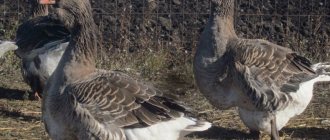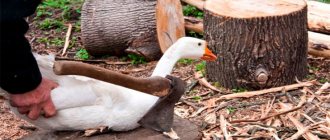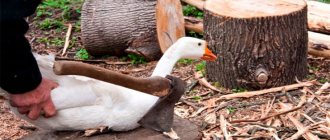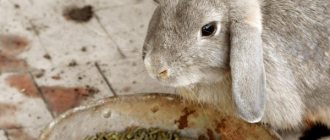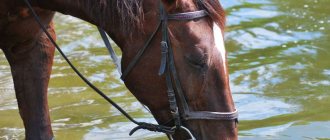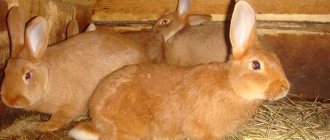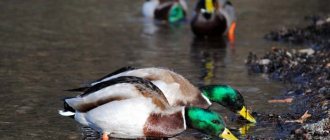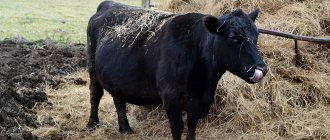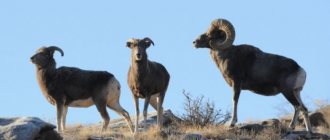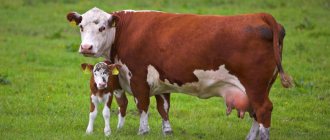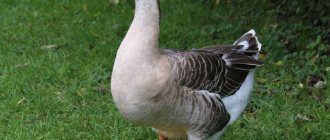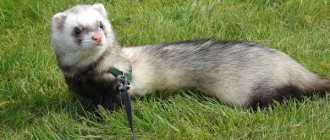The health of goslings and their growth largely depend on proper and good nutrition. Feeding the geese must begin immediately after they dry out. This is due to the following factor - if you start giving the chicks a variety of food at an early stage, they will grow up faster. The yolk remaining in the body will dissolve, and its protective functions will turn on very quickly.
What to feed birds at the first stage
At the beginning of life, babies should not eat solid food until their body gets stronger. In the first 3-4 days after “coming into the world,” the new generation feeds up to 7 times a day.
During this period, the normal food for small birds is eggs mixed with some crushed grain or products obtained from it.
It can be:
- corn;
- oatmeal (small);
- barley;
- wheat;
- semolina;
- bread crusts (soaked);
- compound feed
The product is poured into a container and regular bran, grated carrots and chopped herbs are added to it:
- nettle;
- alfalfa;
- clover;
- you can use forbs.
Trays installed near the heater are filled with the food mixture and the chicks are released. An excellent food for babies can be crushed soaked peas mixed with cottage cheese, fresh chopped grass, eggs and cereal.
Babies can eat greens as soon as they are dry. It is sometimes given as part of a feed mixture (almost 50%) or just like that, crushed to a size of 1-0.5 cm.
Remember the following:
- You cannot store greens for a long time - they quickly lose all their beneficial qualities.
- Babies should not be given regular grains. During the first 20 days, their shells must be sifted out.
Should I give fish oil?
Fish oil is necessary for winged pets - it compensates for the lack of vitamins at times when it is not possible to give the animal succulent food.
Omega 3 fatty acids contribute to the development of strong immunity in goslings and their rapid growth, prevent the occurrence of osteomalacia and rickets, and increase egg production.
You can add fish oil to the food of females and males from the 5th day of their life. First, 0.2 ml, gradually increasing the dosage to 0.5 ml per day.
Mature specimens should be given 2-5 ml of Omega 3 per day per 100 g of feed. A week before slaughter, you should stop feeding fish oil - goose meat may smell fishy.
Self-growing future food
To ensure that the goslings have enough greenery at any time, some farm owners plant barley or oats at the beginning of the year. You can grow them in a few days.
They do it like this:
- They make metal (but without rust), plywood or wooden boxes 4 cm deep.
- Cover them with grain so that 1 cm remains to the end of the side.
- All this is filled with water and the boxes with future greens are placed on top of each other in a dark place.
- After the emergence of seedlings, the boxes are transferred to a lighted area.
Cereals grow very quickly. When they reach 8-10 cm in height, the entire upper part is cut off. The roots remaining inside are watered again and wait for new shoots.
From each such box, 3 crops are freely harvested. It is necessary to cut off the grown greenery before feeding the geese so that it does not wither.
How to make the right diet
Balance of everything and everywhere is always correct and poultry farming is no exception. Successful raising of geese is impossible without the use of balanced diets that take into account the optimal set of components for different ages of the bird. The food must be suitable for the breed and its nutritional needs. Birds, consuming food, must have time to gain fatness and body fat by the time of reproduction.
What do they feed geese on a poultry farm?
A proper diet will prevent the bird from gaining excess fat mass. For this purpose, a method of feeding geese is selected.
Using cottage cheese
Instead of eggs, cottage cheese is often used, which also needs to be ground. If this lactic acid product (12-15 g per individual) is fed to babies from the first days of their existence, then their weight will increase faster and can reach up to 80 g/day.
Experts often replace flour with cottage cheese if necessary. To create various mixtures, lactic acid derivatives such as skim milk and yogurt are used.
On the 4-5th day, you can add beets, potatoes and various cakes to the birds’ menu, which must be soaked in advance. When the chicks are a week old, some root vegetables should appear in their diet. From day 21 they are already allowed to eat food waste.
Making mash
Pure products are rarely given to goslings. More often, various mixtures (mashes) are used. They should be crumbly and slightly moist. It is very easy to check that they are cooked correctly. The finished composition must be squeezed in the palm of your hand. When it is released, the mixture should completely crumble.
The mashes can be given out immediately after birth up to 7 times a day. On the first day, they are poured into shallow trays, which are often used as ordinary trays. In subsequent days, food is kept in wooden troughs, which are filled up to 4 times.
Crumbly wet foods are often mixed with various broths, buttermilk or skim milk. It is important that they are not prepared from foods high in gluten. A mixture with such ingredients can clog the breathing holes, causing the nasal cavity to become inflamed.
In spring and early summer, in most of Russia (center, northern regions) there is no full-fledged nutritious green grass - only small shoots are observed. The diet is supplemented with natural vitamin ingredients.
Add the following to the mixture for feeding small geese:
- mineral feed;
- different types of yeast (feeder, baker's, etc.);
- fine-grained hay dust;
- fish fat;
- herbal flour.
The mix should be varied with sand, chalk, gravel, and ground shells. They are needed for prevention and cleansing of the body. Gravel should be chosen fine-grained. It is necessary to mix it with sand until a homogeneous crumbly mass is obtained.
If you cannot get bone meal, chalk or shell, add 3 g of defluorinated or tricalcified phosphate to each individual. Ready-made mineral compositions can also be added to birds’ food, but they should be kept separately.
Carefully monitor the condition of the feed. It must not turn sour or become covered with a layer of microorganisms (mouldy). Such food can cause various disorders in young representatives of the goose tribe (up to a year old). Some babies get aspergillosis after eating this food.
Diet of geese before laying
Geese are most often bred for meat and eggs. The breeding period begins in February, but laying hens are intensively fed from mid-January. At this time, the goose needs the largest possible amount of nutritious feed containing nutrients, minerals and vitamins. Geese are fed during egg-laying periods up to 4 times a day.
A prerequisite for proper nutrition is the consumption of foods rich in vitamin D. Its absence in the body leads to a sharp decrease in the quality of the shell. The eggs become fragile, thin out and break at the slightest vibration even at the moment of formation, which leads to the death of the bird. To restore the quality of the shell and maintain it at the required level, the feed is enriched with fats and proteins. About 5-6 days before the expected egg laying, regular food is flavored with artificial vitamin supplements. For the convenience of the farmer, a special table can be compiled with sequential entry of information about the quantity and quality of feed consumed by egg-laying geese.
The food consumed by laying hens should be high in calories; fat geese lay eggs better than thin ones, but obesity should not be allowed. Feeders should not remain empty even at night. The basis of the diet is wet and succulent food. Wet mash for geese is prepared from oats, barley and wheat, given twice a day - early in the morning and in the afternoon.
A goose needs to be fed more before laying eggs than others.
During the preparation process, powder from meadow grass, alfalfa and clover is added to the mash. At lunchtime and in the evening, the birds are fed root vegetables, legumes, fish and bone meal, meal, cake, silage, and dry food.
The intake of proteins of plant and animal origin into the bird’s body alternates once every 10 days. Using this simple technique, it is possible to achieve an increase in egg production by approximately 17-19% and the survival rate of young animals by 10-12%.
Quenching your thirst
Birds need not only to eat, but also to drink. It is necessary to provide the wards with good-quality, clean, fresh water from a well, a neighboring river or a water supply system, installing a drinking bowl nearby.
Many goose breeders feed their charges with stagnant liquid from the pond. This is not true. When using such water, you should call the appropriate service and conduct an analysis for the presence of bacteria, microflora, and worms.
After a week and a half of staying in the goose barn, children (for prevention) add ordinary potassium permanganate crystals to the water every other day. The liquid will turn pink. Its depth should allow you to rinse the nose, its cavities and openings.
This is necessary to prevent the occurrence of perosis, in which the tendons are modified and the tibia bones are underdeveloped. The disease leads to restriction of free movement, which is fatal for some individuals.
What to feed poultry raised for meat
From the very beginning, the birds are fed as usual. After a 20-day stay, the diet of the goslings can be slightly diversified by replacing 1/3 of the grain flour mash and mixtures with table scraps or boiled potatoes.
Some of the “free-running” birds living in the goose barn are fattened for meat. From three weeks of age to 70 days, they are recommended the following diet:
- Greens (fresh, finely chopped) - 50%
- Lentils, peas, beans - 10%
- Ground grain - 20%
- Soybean or sunflower cake - 7%
- Wheat bran – 10%
- Ground chalk, shell - 2.5g
- Table or rock salt - 0.5%
For each individual fed for meat and walked in the yard (pasture) until ten weeks of age, the following ingredients are required (in kg):
- greens – about 30-35;
- grain flour mixtures – 9-10;
- various cakes - up to 3.5.
By the end of fattening (before slaughter), the average weight of birds reaches 4 kg.
By simple division we find out that to obtain one kilogram of live weight, it is necessary to spend (in kg):
- grain flour compositions – up to 2.5;
- greens - about 7-8.
Remember! All ingredients are pre-mixed before use.
Rules for feeding birds before slaughter
About 15-20 days before the expected slaughter, the geese begin to be fed more and better than usual. The number of feedings increases to 5-6 times per day, the mobility of birds is limited, and the quality of feed is brought to the highest possible level. Usually slaughter is carried out in late autumn, but in some cases summer slaughter is also practiced. In this case, the basis of the diet is pasture. With proper nutrition, birds quickly gain weight; the total body weight of two-month-old goslings before slaughter is about 4-5 kilograms.
Before slaughter, geese need to be fed more to improve body weight
Meadow fattening
Using pasture as a place for quickly fattening geese allows the farmer to reduce the cost of purchasing green feed several times. Geese are unpretentious to grass diversity, but during the fattening period they should be driven to good pastures rich in vegetation. Fattening of geese for meat begins 1 month before the planned slaughter. Birds are fed with cereals (oats, wheat) and foods high in protein. The daily grain norm per individual is at least 400 grams. Geese must have constant access to feeders and drinkers. It has already been said that at night the activity of geese increases. Therefore, dim lights are left in the poultry house.
It is undesirable to use corn flour and whole corn grains for fattening, since this grain leads to the growth of the fat layer.
By the end of fattening, the birds must have a body weight of at least 6 kg, while the net weight of the goose is 4 kg. The presence of a thin layer of fat between the skin and the flesh is acceptable, but fatty internal organs indicate that fattening was done incorrectly.
Intensive fattening
With intensive fattening, birds will gain their required weight just 2.5 months after birth. Such indicators can be achieved by completely limiting the movement of birds not only in the pasture, but also in the poultry house itself. Geese are placed in special boxes with a hole for the neck. They are fed with mixed feed and grain. Forced fattening is practiced. To do this, prepare a mixture of corn, barley, oat and wheat flour, wheat bran, taken in approximately equal quantities. The finished mixture is salted, rolled into balls, moistened in water and forcefully stuffed into the open goose's beak. It is more convenient to carry out the procedure together.
With this method of feeding, birds gain up to 120 grams of weight per day, which allows them to be slaughtered 2 weeks after the start of fattening. The intensive fattening method increases production profitability by up to 170%. Beginning farmers are interested in whether any grain can be used to fatten birds. The answer depends on the intended purpose of the geese. Thus, rye reduces the healing properties of goose fat. Its use by birds preparing for slaughter is undesirable, but during prebreeding fattening it is quite possible.
Feed for birds prepared for breeding
The birds, which are supposed to be allocated for procreation, are released onto pastures from the age of three weeks. They try to feed them better, using carrion from cereals, seeds of various plants, take them to meadows with lush grass and feed them 1-2 times.
Some goose breeders feed them a medicinal and nutritional milk-yolk mixture in the first 48 hours after the birth of their babies. Weak chicks are given it until the babies recover.
It's easy to prepare the mixture:
- Break the egg and separate the yolk.
- “Whirl” it in 1⁄2 cup of milk.
- Pour a pinch of sugar inside.
- Biomycin or penicillin is added.
Grown-up individuals are fed a little differently. They are given concentrated feed - whole grains of cereals and peas. This is done until the flight feathers grow completely. After this moment, their food becomes only greens collected in the garden, forest, vegetable garden and growing in pastures.
Feeding geese during the breeding period
If birds are given only kitchen scraps or grain-flour mixtures, then the females will only get fatter and lay unfertilized eggs. To prevent this from happening, during this period and 30 days before it, birds from the parent flock are given access to any type of food.
To obtain high-quality eggs, the geese menu should be diversified and added to regular feed:
- rot;
- various greens;
- silage;
- vegetables - pumpkin, turnips, carrots, rutabaga, etc.
Very large hay needs to be chopped, steamed and covered with bran or something else. All vegetables should also be prepared - scalded or boiled so that they become softer.
During the breeding period, it is necessary to maintain and increase the level of live weight. According to statistics, well-fed geese have high egg production.
If the irreparable happens and the weight of the wards begins to decrease, it is necessary to increase the nutritional value and amount of food. When switching to such a diet, one adult should be given at least 400 g of mixed feed or 600 g of other feed.
Due to the peculiarity of geese, they eat whenever they want - they add food to the troughs even at night. By consuming so much, geese perfectly absorb all the nutritional components of even roughage.
During this period, “bulk” feed should be provided (about 200 g per individual):
- chopped corn;
- chaff.
Every day the birds are given 0.3 kg of dust and flour. Geese will eat more roughage if you add various concentrates, potatoes, and beets (sweet).
The geese body easily digests “difficult” ingredients, such as fiber from cereals and other foods.
Digestibility of feed fiber, percentage
| Feed | Geese | Chickens |
| Barley | 45,5 | 30,0 |
| Wheat bran | 59,6 | 5,69 |
| Soy short | 46,0 | 12,56 |
| Red clover (green mass) | 68,3 | — |
| Oats (green mass) | 78,6 | — |
| Peas, grain | 46,0 | 10,0 |
| Field sow thistle | 48,0 | — |
| Clover hay | 63,7 | — |
| Clover silage | 100,0 | — |
| Red carrots | 100,0 | 50,0 |
| Fodder beet | 76,5 | — |
During the period when egg production ends, which lasts six to seven months, birds are fattened in meadows and other areas from spring to winter.
If the use of a paddock is not provided, and the geese are sitting on an area enclosed by a fence, they are fed with various greens in certain proportions.
Feed requirements of geese (grams per head per day)
| Age group | Dry feeding type | Combined feeding type | |
| Concentrated feed | Juicy food and greens | ||
| Goslings 1-5 days | 35 | 18 | 30 |
| Goslings 6-10 days | 90 | 40 | 50 |
| Goslings 11-20 days | 110 | 50 | 100 |
| Goslings 21-30 days | 220 | 120 | 200 |
| Goslings 31-40 days | 280 | 140 | 300 |
| Goslings 41-50 days | 328 | 160 | 400 |
| Goslings 51-60 days | 338 | 180 | 500 and more |
| Repair goslings 61-240 days | 260* | 180 | Plenty |
| Adult geese | 330* | 220 | 500 |
Males whose weight has decreased significantly during this period are prescribed enhanced feeding.
A specially developed mixture of the following composition (g per individual) is inserted into their regular daily menu:
- proteins – 10;
- carrots – 50;
- grain – 100.
Lactic acid mixtures are often used as proteins when feeding geese.
Feeding is organized as follows:
- Ganders that need a supplement to their diet are painted on the wing and locked up.
- The remaining birds are driven out into the yard or pasture.
- Birds with reduced weight are fed and then released into the wild.
At first, males become agitated, pinch and refuse to eat. After several days, they themselves do not leave the room along with other birds, but remain and wait for feeding.
Vitamins necessary for healthy growth of geese
Vitamin D
Effect on the body
It is necessary for the rapid absorption of various mineral components from the foods eaten during the formation of the skeleton of young animals and shells in the body of an adult goose.
Its deficiency causes rickets in the younger generation. In laying hens, processes occur in the body that manifest themselves in changes in the appearance of the egg shell, either very thin or not at all.
If vitamin D levels are very low, the goose may not be able to lay eggs.
What products contain
For geese, D3 is important - cholecalciferol, which is much more active than other vitamins in this group.
In its natural form, it is found in liver, fats (milk and animal), and yolk.
It can be obtained artificially by irradiating yeast.
Vitamin B2
Effect on the body
It is necessary for birds to quickly and efficiently hatch chicks.
Its lack affects hatchability, which can decrease significantly. If there is a lack of substance in the herd, weak individuals of both sexes are observed.
What products contain
The following foods and plants contain a lot of B2:
- greens, grass, leaves;
- yeast;
- cottage cheese;
- flour (animal);
- regular milk;
- juicy hay;
- rot.
Feeding standards and basic diet
What to feed adult geese to increase weight gain? The daily diet of one adult should include at least two kilograms of fresh greens per day. In addition to grass, the following should be added to the feed:
- Carrots: 100 g;
- Boiled potatoes: 500 g;
- Grain: 70 g;
- Mineral supplements: 25 g.
How to feed
Geese are given food 3 times a day. The first feeding is at 7 am. You can include sprouted grains in the composition.
At 15:00 the second feeding occurs. You can feed boiled potatoes, raw sugar beets and other recommended foods.
Third feeding at 20 pm. It includes leftovers from the daily feed allowance.
[ads-pc-1]
Minerals
Nothing can replace them. They are necessary not only for babies to strengthen the skeletal system and body, but also for adults during laying to form the shell.
These are the following chemical elements contained in feed:
- silicon,
- calcium,
- iron,
- potassium,
- sulfur,
- phosphorus,
- manganese,
- chlorine,
- iodine,
- cobalt,
- zinc,
- sodium,
- and others.
Most of them are found in bone meal, chalk, sand, and shell. Mineral-containing food is often included in the menu of birds, pouring them into separate troughs.
Coarse sand and fine gravel are needed to grind food in the esophagus and stomach. Geese do not have dental plates and cannot grind their food. The gravel-sand mixture, working as a millstone, helps the geese completely process the feed.
Organization of proper nutrition
Proper nutrition of poultry is the basis of successful poultry farming. The growth rate of young animals, the productivity of mature animals and the quality of the final product depend on the content of useful substances and minerals in the feed. The food supply for geese is compiled taking into account the genetic characteristics of a particular breed.
Poultry farmers monitor the amount of feed consumed by birds daily, which helps prevent them from suddenly losing weight or becoming obese at the beginning of the breeding period. Birds tend to accumulate fat, which reduces the yield of clean meat. This cannot be avoided, but a specially formulated feed ration will not allow the goose to become completely fat. As a rule, for this purpose, dry food is reduced and the proportion of wet mash in the daily nutritional ration is increased.
Kitchen waste
In any family, after eating, some kind of waste remains - leftover dishes, fish heads and tripe, tails, pieces of meat, scales, uneaten food, etc. After preliminary preparation, all this can be included in the diet of birds.
The process is as follows:
- All ingredients are crushed and boiled.
- Prepare wet mash and offer it to the geese.
Fish waste (head, tail, bones), in addition to mineral components, also contains proteins. This waste is fed to birds on average 25 g per individual.
You can add a variety of cereals and bread (black or white) in any quantity to wet food. When adding bread (soaked crusts), you need to prepare crumbly mash.
Greens and root vegetables (table scraps and those grown on the site) are chopped and given to the birds. About 200 g per individual is mixed into the food.
Potato
Experts advise feeding geese with potatoes. It is not necessary to use good tubers. Birds can be given small, low-quality fruits, but they will need to be boiled.
The inclusion of this product (0.2-0.3 kg/individual) increases digestibility:
- all feeds in total by 25%;
- separately fat by 20%;
- fiber by 3-3.5 times (oat fiber by 11%).
It is prohibited to give sprouted potatoes to birds. It contains solanine, a dangerous toxin. To get rid of it, potatoes are boiled. The toxic substance goes into the water. After cooking, the liquid must be poured out. It is prohibited to use it during cooking.
You can give birds raw potatoes, but you need to accustom the birds to it from childhood. It is washed, crushed and 10% of the total weight is added to the mash of birds that are 10 days old or more. After 40 days, the amount of raw product is increased to 50% of the mass of the mash.
In addition to potatoes, birds are given up to 25% of green space. The remainder is distributed among concentrates and kitchen waste. With such a varied menu, by the 40th day of birth, each member of the flock will have decent plumage and weigh a little more than 3 kg.
Signs of improper feeding
The health status of geese can say a lot about their diet:
- diarrhea, digestive tract upset indicate an excess of greens in the diet and excessive drinking;
- difficulty breathing and coughing are signs of high consumption of dry food; the bird should drink enough and eat wet food;
- loss of plumage, lack of appetite, refusal to graze signal a lack of vitamins;
- lethargy, lack of appetite, refusal to eat may be a sign of poisoning by poisonous plants.
Untimely measures can lead to the development of disease or even death of the individual.
Preparing feed for geese for the winter
When walking, birds eat the seeds of a variety of plants. You can make preparations from them and, in cold weather, replace some of the usual grain-flour food and mash.
First, they wait for the seeds to fully ripen and collect them. After this, they are ground, wet mashes are prepared and fed to the birds, giving 35-50 g per individual per day.
Trash, grass flour
To fully provide birds with vitamins during the winter cold, you need to prepare vitamin-protein food in the required quantities.
Herbs: mouse peas, quinoa, nettle, greens from huastka. Cereals: sow thistle, millet, timothy. Legumes: alfalfa, clover.
All plants should be removed before or during flowering. In order to have enough vitamins, you need to dry the herb in a dry space. Ideal places for this are attics. Hangers are installed on them to place the herbs in one layer.
If the color of the hay remains the same as before drying and has hardly changed, then most of the nutritional components remain in it. Dried plants are placed in another similar place or left there.
Brooms
To fatten birds in the cold season, leafy (up to 1 cm in diameter) branches of various trees are harvested, from which brooms are knitted. They should not be susceptible to diseases or affected by various microorganisms (viruses, fungi) and pests (for example, aphids).
Knitted brooms are secured on hooks in dark spaces under the roof and in attics. Many goose breeders place them on hangers. When feeding birds, brooms, which geese readily feed on, are placed so that the birds can easily reach them.
Remember! Ground leaves are often included in mash mixtures (about 100 g/individual per day).
Needles
In winter, it is useful for birds to eat spruce branches of fir, larch, pine, and cedar. Select branches up to 1 cm in diameter with needles. Some goose breeders give it to their clients without processing it. But before that, they accustom the young animals to such food and begin to do this when the babies are 10 days old.
The majority of goose breeders chop needles with an axe, pruning shears, and scissors. It is prepared right before food is given to birds (30 g/individual).
Pine needles contain a large percentage of microelements, vitamins (B2, C and others) and carotene - about 70 mg. When eating this product, geese become more fertile and the pigmentation of their beaks and legs improves.
Remember! Pine needles contain a lot of tannic components and harmful oils (especially in summer). Therefore, it is harvested from late autumn to spring.
It is often stored in pits or directly on the ground, making a sandwich:
- Lay (in depth) 0.5 m of chopped pine needles.
- Cover it with a 20 cm layer of snow.
- Repeat the first 2 points.
- The finished sandwich is covered with a half-meter layer of snow and wrapped in straw.
- When necessary, the product is removed and given to the birds.
Sometimes it is prepared in a different way:
- Stretch a net in a dry, closed space and place spruce branches on it.
- After 2-3 days, the needles will dry out and fall to the floor between the mesh cells.
- After sweeping the room, a large armful of product will be collected - about 30% of the total weight of spruce branches.
If the needles fall off poorly, you can shake the spruce branches or tap the mesh with a stick. There are about 70-85 mcg of carotene per gram of this product. In addition, it contains anthelmintic substances that help geese in the fight against ascariasis.
Dried needles are eaten reluctantly by birds. They need to be put through a meat grinder to grind. Only after this do the birds eat them.
Various plants are suitable for this method of preparing and storing feed, except for nettles and legumes, which require additional carbohydrate-rich ingredients for good ensiling. This method allows you to preserve all ingredients for a long time.
When is the best time to ensile different plants:
- cereals – at the stage of ear formation and formation;
- legumes - at the beginning of bud growth.
Corn is harvested in different growth phases:
- cobs - when it is ripe;
- greens - when throwing out panicles.
A good help is to add 50% sugar beets to the total mass. For ensiling all these plants, only fresh components, recently mowed or harvested, are taken. The moisture content of the harvested feed should be 70–75%. If it is lowered, more juicy herbs are included in the total volume. If this indicator is exceeded, flour or dust is added.
When harvesting and canning corn waste for the winter, together with legumes, cabbage, root vegetables, tubers, grains and herbs, an excellent combined mass is obtained. Such silage can partially satisfy the need of birds for carotene, replacing not only expensive concentrates, but also conventional products (flour, carrots) containing vitamin A.
Composite Silage Compositions
Recipe 1
- Fodder beets with tops – 35%
- Carrots with tops – 50%
- Hay flour from legumes – 15%
Recipe 2
- Meadow grass forbs - 40%
- Alfalfa or clover aftertaste - 20%
- Corn cobs - 40%
Recipe 3
- Small steamed potatoes - 30%
- Red carrots with tops – 30%
- Cabbage leaf - 40%
Recipe 4
- Corn cobs wax ripeness - 60%
- Fodder beet with tops – 40%
The mass prepared for ensiling can be freely crushed into small parts in a mortar, crushed with pruning shears in any trough or basin, passed through a vegetable cutter or meat grinder, add up to 3% salt and mix. It is necessary to store up to 70 kg of such food for one individual.
It is advisable to pour the finished product into tightly closed wooden tubs or ceramic jugs, insert or screw the lid and cover it with wax or clay to prevent air from penetrating inside the vessel. Before this, the mass must first be compacted,
Silage storage
The tubs are installed in the cellar or basement. Temperature thresholds should be within -3+1 °C. In the absence of wooden tubs, the product is placed in a hole dug not far from the goose barn on some hill. Its walls are lined with brick and coated with cement or clay.
The feed mass is poured so that its edge rises 55-70 cm above the pit. Then straw is cut and the resulting mound is covered, which is coated with a 15 cm layer of clay and covered with earth (0.3 m). When cracks and landslides occur, they are sealed with clay or earth.
Before frost, the pit with finished silage is covered with an additional layer of straw. It matures within 40-60 days. After their expiration, it is given to the birds, pouring the mass into separate troughs or adding it to grain and flour food.
What grass do geese eat?
The bird with particular pleasure eats juicy greens containing many leaves. These are: dandelions, cornflower, quinoa, wheatgrass, shirita, loach, plantain, silphium, comfrey.
When feeding livestock in pens, the grass is chopped to a length of 4–6 cm and given as part of the mash or simply placed in feeders. Young tender greens are placed whole in lattice mangers or hanging vendaces.
On the pasture, geese eat young shoots of meadow grasses (urchin, brome, fescue), oats, and corn. Nutritious legume crops are sown especially for the livestock: alfalfa, sainfoin, clover.
The birds are released onto the pasture when the grass stand has risen by 12–15 cm. To ensure that grazing occurs evenly, the movement of geese is limited to light pens. They are moved to a new place as the birds eat the grass. For grazing, drinkers with clean water must be installed if there is no pond.
Preparation of root crops
Experts advise keeping them in a cellar or basement. Vegetables such as cabbage and carrots are richest in vitamins. To reliably preserve them, the temperature should be within -4+3 C.
Red carrots
One of the most valuable feeds. This dietary vegetable is suitable for geese of any age. It is issued to birds in any form. You can dry or salt it, ensile it, or put fresh carrots in feeders.
To store it, make a sandwich:
- The floor of the cellar is covered with 5-10 cm of earth.
- Place vegetables on it in 1 layer.
- Make several of these “earth-carrot” rows so that their height does not exceed 0.7 m.
Carrots surpass all other plants in the percentage of carotene. In a gram of product, vitamin A is found - about 75-100 mcg. With simple storage in a special or regular cellar, its quantity is reduced by almost half by spring.
To maintain the level of vitamins, the vegetable is placed in barrels and salted, adding up to 3% salt. This product should not be immediately fed to birds. Before serving, carrots must be soaked in water.
Feed cabbage
Substandard (unfit for food) cabbage has a large amount of useful substances. It is piled up and stored under a thick (10-30 cm) layer of snow or salted.
Before feeding, it is thawed and given to the birds. Babies can eat it when they are 3-4 days old. They consume up to 0.2 kg of this product.
The content of vitamins B1 and B2 per 1 g of product is 2 and 5 mcg, respectively, and carotene is about 70 mcg. Scientists have found many different amino acids with a high sulfur content in this vegetable. They are necessary for plumage growth and increase in its quality.
Types of feeding birds
Depending on the season and what nutritional components are available, one of three types of poultry feeding is practiced at home:
- dry;
- wet;
- mixed.
Making wet mash for geese is not at all difficult.
In small private farms, geese are most often fed wet mash with the periodic inclusion of ground cereals, feed of plant and animal origin in the daily diet.
To prepare mash, corn, oat or wheat grits are used. A high-quality mash is mixed with water, milk or whey, stored for no more than 3-4 hours, does not resemble dough, and crumbles when it falls to the ground. Wet food can be poured on top of dry food, but it is prohibited to store it in the feeder. Sour and moldy food can cause the poultry population to become infected with dangerous diseases.
Combined, or mixed, feeding involves the simultaneous use of dry and succulent feed (sugar beets, potatoes, silage).
Food based on cereals and cereals
Meadow, field and garden plants in any form (whole, chopped, crushed) are the basis for the production of nutritious feed for birds. They contain a high concentration of carbohydrates, which are needed to maintain many internal processes of the body. These foods have a high calorie content and good taste; birds eat them eagerly.
The carbohydrate content of cereals (their grains) is as follows (in percentage):
- mineral components – 4;
- natural fat – 8;
- amino acids and protein – 12;
- starch - about 70.
Corn
A grain product containing all of the listed carbohydrates in large quantities, with the exception of protein. It's only 10%. This cereal contains little sodium, manganese, vitamin B, and potassium.
Although there is only 20 mcg of carotene inside, this cereal is far ahead of other plants in terms of nutritional value (in percentage):
- oats about 30;
- millet – up to 15.
Birds should not be given food that is half corn.
Barley
The grains of this cereal, and other species of this family, are covered in transparent skin. Scientists have counted about 60% carbohydrates in barley. Adult birds are given it immediately after cleaning.
Babies who have not yet turned 20 days old cannot be fed such food. Their stomach walls have not yet hardened - the shell of the grains can stick to them and close the esophagus, which will lead to the death of the goslings.
They are given pre-screened, ground or crushed barley, the amount of which should not exceed 40% of the total weight of the feed.
Millet
Some varieties of this cereal (yellow) have a lot of carotene. It is fed to birds in the amount of up to 15% of the weight of the rest of the food. Chicks up to three weeks of age are given crushed or ground millet.
Oats
It is considered the most high-calorie grain. Although the percentage of oat hull is about 10% of the weight of the grain, it is not prohibited to give it, because it is easily digested. Adults are given oats in any form, and babies (up to 20 days) are recommended to be fed this grain in small quantities after sifting from the shells.
After all, even in substandard varieties of cereal there is a large percentage of fiber - about 25%, which is poorly digested by a young body. This can lead to blockage of the esophagus and death of the chicks. It is advisable to feed babies coarse flour or oatmeal, at the rate of 1/3 of the total food.
Wheat
Birds are always fed feed (unsuitable for food) wheat of various types. It is slightly inferior in the amount of protein (about 14%) and nutritional value only to corn.
Wheat is crushed or ground before being given to birds of any age. The ratio of the mass of cereal grains to the total weight of the feed is no more than 1/3.
Cereal waste
A huge advantage in the process of feeding birds is the use of grain waste and their chaff. They include not only cereals, but also legumes.
Remember! It is forbidden to feed waste from traditional grains to babies. They are intended for adults only. All feed must be checked. They must be mold-free, dry and free of seeds of various weeds.
You don’t have to crush or chop the food; adult geese eat it whole. But they are very selective and prefer sweeter varieties. The most nutritious waste is considered to be feed corn and wheat waste. The menu of birds may contain up to 30% of such food. Legumes always contain more protein than grains. But some of them (ground peas, for example) are eaten in small quantities due to the pungent odor and unpleasant taste, which geese do not really like. This plant can be given to chicks in an amount of 2-3%. As the young animals grow up, the norm is gradually increased and brought to 15%. The same is done with lentils.
Symptoms of an incorrectly selected diet
Exceeding the amount of greens in the daily diet of young animals leads to gastrointestinal disorders. In addition to this, excessive water consumption can make the situation worse. It is necessary to reduce the rate of input of green feed and reduce water consumption;
A high percentage of flour food leads to coughing and difficulty breathing. It is urgent to reduce the percentage of input of this feed and increase the humidity. Set up a feeder into which wet sand or shell rock is poured. These components will allow the bird to clean its aviary. If the situation is critical, then water is forced into the beak.
Geese can find harmful plants on the run, guided by their smell, and do not eat them. But this is easy for adult birds, and young birds may accidentally eat poisonous grass at first, so their appearance on the site should be excluded. In case of poisoning, geese are given plenty of fluids to drink and the stomach is washed.
At the beginning of the walking season, if there is a pond nearby, the geese may experience indigestion. This happens due to the toxic effects of silt, shells, and fish consumed by geese. Simultaneously with these components, pathogenic infections enter the bird’s body. In this situation, the bird is prescribed antibiotic treatment. After this, immune bodies are produced and therefore the geese adapt to food from reservoirs.
Feed from agricultural raw materials
In the production of various specific oils by squeezing and pressing plant seeds, cake can be obtained. And using the method of direct or indirect extraction, it is extracted from the mass of meal. All these secondary products are excellent food for birds of different ages. Meals can contain up to 3% vegetable fats, and cakes can contain up to 6%. A good help is the use of yeast, bran and mill dust.
| Meals and cakes from the plant | Protein presence % | Other substances | additional information |
| Sunflower | 40-42 | Methionine and various amino acids. | They are present in the bird menu in an amount of 7-20%. This entirely depends on the age of the individuals. |
| Linen | 34 | Fat – 8%. | There are as many of them in the diet as there are in sunflowers. |
| Soybeans | 42-45 | Fat – 15%. Many different amino acids. | — |
| Corn | 20-22 | — | Give it to babies - 10-15% is mixed into the food along with other types of cakes. |
| Cotton | 36-38 | Fat – 7%. | It is mandatory to check for the presence of toxic contents - gossypol. This poison is dangerous for geese. If the test reveals the absence of this substance, then 5% of the product is introduced into the food and fed to babies from 11 days. As they grow older, its content increases to 10%. |
| Hemp | 33 | Fat – 9%. | Due to the presence of a large percentage of narcotic substances, feeding these cakes and meals to birds is allowed in amounts up to 5% from the age of one month. |
Wheat bran contains very few useful elements; it is a rough food that takes up a large volume. Although their value is not very great, they should be present on the menu of birds. About 20-30% of this product is added to the feed. Its quantity depends entirely on the age of the individuals.
10-20% of gray and white flour dust can be freely given to older individuals during the non-productive time of their life. Feeding yeast is always used when feeding birds and animals - it is rich in vitamins and protein, which contains a large amount of amino acids. All these elements are necessary for birds to function normally. Adults are fed 10% yeast, and babies 3% or less.
Feeding for goslings aged 2 to 4 weeks
The best food for geese at this age is greens. Most summer residents completely switch their birds to “find it yourself, eat it yourself” feed. That is, they are driven out into a large pen (in which these insatiable creatures have not yet had time to eat and trample everything) and generally stop giving food. All day long they must look for their own food and choose the grass they like best. As practice shows, goslings will choose only the most suitable plants for them and will feast on healthy and nutritious leaves and roots.
After a few days, when the amount of food on the “plantation” has decreased significantly, you can feed them with mealy feed and crushed grain. Their stomachs have already learned to produce all the necessary enzymes, and their bodies are saturated with vitamins during the period of eating greens. They will easily digest even raw grains and cereals, which should make up no more than 20% of their diet, so as not to overload the body with heavy foods.
At this time, it is worth starting to intensively feed beets, carrots and pumpkin. Such a diet will allow the bird to saturate the body with ascorbic acid, carotene and B vitamins. Thus, the metabolism will increase significantly and natural weight gain will occur. You should not delay too much with the introduction of vegetables into the diet of geese, and if they accept them normally, you can feed them already from the 4th week of growth.
Animal feed
Biologically, they are very valuable, playing a huge role in feeding geese. They are quickly absorbed by birds, increase the productivity of older individuals, ensure weight gain in babies and young birds, and increase the incubation properties of eggs.
These foods include:
- slaughterhouse waste;
- all lactic acid products;
- blood;
- various types of animal meal.
Milk and milk-based products
They are an excellent food throughout life, starting from birth. They are especially needed by babies in the first days and older individuals during the productive period.
| Product | Intelligence |
| Milk | It contains many mineral elements and various vitamins necessary for the growth of young animals. It contains about 3.3% natural protein with a huge list of amino acids. |
| Cottage cheese (low fat) | It should be given in mash (wet) to babies from 2 days to 15 days of age. This product contains 6-16% protein, which is quickly digested by the goslings’ body. |
| Serum | It contains very little natural protein. But it contains sugar and many subtypes of B vitamins - almost as much as whole milk. Using whey, goose breeders often mix different feeds and feed them to birds of any age. You can give this liquid in its natural form by pouring it into drinking bowls. |
| Buttermilk | This is not a rough product, so it can be fed to babies and adult geese. |
| Skim milk and other lactic acid products | They are necessary when preparing mash for babies who are 2-3 days old. |
It is prohibited to store and serve dairy products in galvanized containers. The interaction of this organic substance with a chemical element is a toxic compound, which will cause the death of birds.
Blood and slaughterhouse waste
Before feeding, they are first boiled and then crushed. The resulting product is fed to 5-day-old babies - up to 15% of the total weight of the feed mixture.
Remember! It is forbidden to feed birds with water in which waste was prepared.
What do domestic geese eat?
Poultry farmers who raise waterfowl at home need to prepare a diet based on local conditions, and not look at how geese are fattened in poultry farms. There are certain standards that must be observed when feeding these large domestic waterfowl, but first you need to decide what will go into their food and what cannot be given under any circumstances. It is worth remembering that spring and summer diets are very different. Here's what to feed geese at home:
- Fresh green grass or other similar food. In summer, during the grazing season, it is best to give the birds fresh grass or even let them out to graze in the meadow, but in winter you will have to use silage (prepared green food) and hay.
- Vegetables and tops of various agricultural crops. They are often given along with fresh grass in order to diversify the food of waterfowl, and for the winter the tops are prepared by ensiling.
- Various root vegetables. They are worth mentioning separately from other vegetables as a very high-calorie food. It is the root crops that farmers use when fattening geese for meat. Potatoes, turnips, beets or carrots are worth considering, although other root vegetables will work. If we talk about beets, then both the sugar and fodder varieties are suitable.
- In the wild, geese often feed on various foods of animal origin, so when feeding them at home, you can give them similar food. Many poultry farmers use fish waste from both sea and river or lake fish. You can also give these waterfowl skim milk (skimmed milk) or whey. They are suitable as a base for various porridges.
- Grain crops and compound feeds. Often, when feeding this bird, various cereal feeds and cereals based on them are used. You can also make it the basis of the diet and feed, but you must remember that not every feed is suitable for raising domestic geese.
In this case, we must take into account the fact that different foods are suitable at different times and for different groups of birds. What is used for raising small goslings is not suitable for laying hens. And if you need to choose what to feed geese for meat, then it is undesirable to take the same diet as for the breeding flock. There are also different feeding options for the same season and the same birds. And you should choose them based on your capabilities and preferences. The availability of pasture, the cost of various feeds, and much more play a role here.
Coarse sand, gravel, pebbles
These minerals are needed by birds to ensure reliable grinding of the product in the body. Geese do not have dental plates, so these elements work instead of them and grind food like millstones.
Feed for geese
It has been experimentally proven that adding sand, stones and gravel to geese’s food increases the digestibility of any feed by 15%. It is necessary to constantly add gravel to the feeders.
Fattening poultry for slaughter
Geese are kept in pens and given a large amount of food, half (by weight) of greens. The remaining 50% includes concentrated components and waste from the garden, garden, and kitchen.
Food collected from the site may include vegetables and fruits that are unsuitable for eating:
- tops and roots of various crops;
- non-edible potatoes;
- improperly formed heads of cabbage;
- fallen cabbage leaves;
- fruit and vegetable carrion.
Birds are placed together or in cages, allocating 2-3 individuals per square meter. Feeding is carried out three times a day every 6 hours. Geese are given millet, sifted barley and oats, and bran (wheat). You can offer birds grain (steamed or soaked).
To avoid loss of appetite, after the next meal you need to clean the troughs of grain and various mixtures. You can leave the food overnight - birds often feed in the dark.
After the geese reach the required weight, they are gradually killed. At the end of this process, the pen is prepared to receive a new batch of geese.
During this period, all individuals molt once, but before slaughter the plumage has already grown back completely, and the carcasses become larger. By this point, their weight can reach 5.5 kg.
The meat of young birds contains up to 19% protein, and only 10% fat, because part of its deposits is burned. The carcass contains a large number of muscles, due to the growth of which body weight increases.
Features of raising birds in various conditions
There are 3 periods in keeping geese.
- Pasture. Starts in June and ends in October.
- Tribal. January February. Time of intense egg laying.
- Pre-tribal. Starts in November, ends in January. It is common practice to fatten individuals ready to lay eggs.
The diet of geese must contain protein
In winter, the feed ration is formed taking into account a possible sharp decrease in the weight of the bird due to cold weather. To prevent this from happening, food must be high in calories at the rate of 950 calories per individual per day. In the summer heat, the number of calories drops to 825. At the same time, the farmer must ensure that each bird receives at least 46 grams of protein per day.
Maintenance in summer (during grazing period)
While on the range, 1 goose consumes from 2 to 4 kg of greens per day. At the same time, birds do not feed on grass alone. Three times a day, feeders are filled with legume flour, chopped corn cobs, and steamed oatmeal and millet chaff. Pets are fed mixed feed or grains twice a day. The water in the drinking bowls is changed up to 3 times a day. There should be exactly as much food as 1 bird can eat at a time. Spoiled food is thrown away, feeders are washed and dried.
In anticipation of large increases in the population, it is most profitable to keep geese on pasture located near a natural source of water - a river or lake.
Maintenance during the pre-tribal and breeding periods
Closer to October, birds stop walking; at this time, the question of what to feed geese so that they gain weight is especially relevant. Birds are placed in special rooms. As such, an insulated barn equipped with drinking bowls and feeders is used. The floor in the poultry house is covered with straw, the doors and windows are caulked. On the eve of the breeding season, group and family keeping of geese is practiced. Meals should be three times a day, including wet mash, dry food, sprouted grain, compound feed and root vegetables. To increase egg production, the number of feedings is doubled, and preference is given to food rich in calories and nutrients. Sometimes geese are even fed bread.
